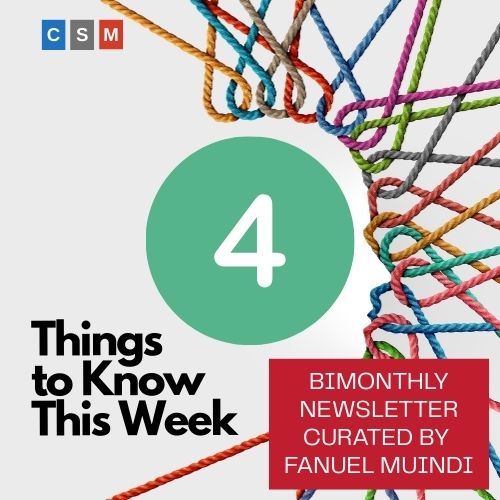CivicSciTV - Questions of the Day
Inside Genspace: Exploring the theory of change behind the world’s 1st community biology lab
CivicSciTV’s Questions of the Day Host Fanuel Muindi sits down to talk with staff members Casey Lardner and Vanessa Champagne from Genspace, the world’s first community biology lab located in the heart of Brooklyn, New York. Fanuel asks a range of questions covering the theory of change, the meaning of impact, partnerships, challenges, members, and so much more. Vanessa and Casey share insights on the evolution of the lab, the impact of their work on local communities, and the challenges and successes of operating a community-based scientific environment. They delve into the various community projects including their Break into Biotech program that they recently launched with support from the New York City Economic Development Corporation.https://www.genspace.org/
Key Insights
1. Community Engagement and Education: One of the foundational aspects of Genspace’s operation is its emphasis on community engagement and education. The lab is not just a place for conducting experiments; it serves as a learning hub for people from diverse backgrounds including artists, tech enthusiasts, and entrepreneurs. This model fosters a unique interdisciplinary approach to science, making it accessible and engaging to a broader audience. This has been successful in demystifying science and making it part of the community’s daily dialogue.
2. Hands-On Science: Genspace offers hands-on experience in various scientific fields such as biohacking, genetic engineering, and biomaterials. This practical approach is crucial in a field where traditional educational institutions often rely heavily on theoretical knowledge. By enabling community members to engage in real-world scientific activities, Genspace not only enhances their understanding but also stimulates innovation and creativity in scientific endeavors.
3. Challenges: Operating a community lab comes with its own set of challenges. Funding remains a significant hurdle, as the operation of such a lab is costly, and finding financial support for adult education and innovative projects is often more challenging than for youth programs. Additionally, balancing the educational needs of a diverse group of participants requires constant adaptation and development of new teaching strategies that minimize jargon and maximize engagement.
4. Impact Measurement and Theory of Change: The impact of Genspace is measured not just by the scientific outcomes but also by the personal growth and development of its members. The lab has seen individuals with no prior scientific background becoming proficient and even changing their career trajectories. This aspect highlights Genspace’s role in shaping science identities where individuals see themselves as capable of contributing to science regardless of their original field of study or profession.
5. Future Aspirations and Expansion: There is a clear vision for the future expansion of Genspace to make its offerings more accessible to a wider audience. The idea of replicating the Genspace model in other boroughs or regions reflects a strategic goal to decentralize and democratize access to scientific education and community collaboration.
Conclusion
The conversation with Genspace representatives underscores a transformative approach to community science education. By lowering barriers to entry, fostering a collaborative environment, and emphasizing hands-on learning, Genspace is not just educating but also empowering citizens to engage with science in meaningful ways. This model serves as a blueprint for future initiatives aiming to integrate science into community settings globally.
Follow Up Questions
- (1) How does Genspace prioritize its resources among various projects and educational programs? What criteria are used to determine the allocation of limited resources?
- (2) How does Genspace assess the educational outcomes of its programs? Are there specific metrics or feedback mechanisms in place to measure the effectiveness of your teaching methods?
- (3) What has been the most surprising feedback from the community regarding their experience at Genspace? Can you share examples of how specific feedback influenced your operational or educational strategies?
- (4) What are the biggest challenges (beyond funding) for community science labs like Genspace in the near future?
- —
This conversation was made possible by support from the New York City Economic Development Corporation (NYCEDC). Visit Https://edc.nyc to learn more. Fanuel Muindi is a Professor of Practice in Civic Science at Northeastern University in the College of Arts, Media, and Design.
Fanuel Muindi is a former neuroscientist turned civic science scholar-journalist and entrepreneur. He is a Professor of Practice in the College of Arts, Media, and Design at Northeastern University where he leads the Civic Science Media Lab. Dr. Muindi received his Bachelor’s degree in Biology and PhD in Organismal Biology from Morehouse College and Stanford University respectively. He completed his postdoctoral training at MIT.

-
Civic Science Times4 weeks ago
Ecosystem building in action: Science Talk 2025 and the dynamic civic science conference landscape
-
Civic Science Times1 week ago
Dear Colleagues: Now is the time to scale up public engagement with science
-
Civic Science Times2 weeks ago
Weekend Watch: At Boston College, the McMullen Museum of Art presents “Wonders of Creation: Art, Science, and Innovation in the Islamic World”
-
CivicSciTV - Questions of the Day4 weeks ago
Dr. John Besley shares the actionable insights from the Nature global study on trust in scientists





















